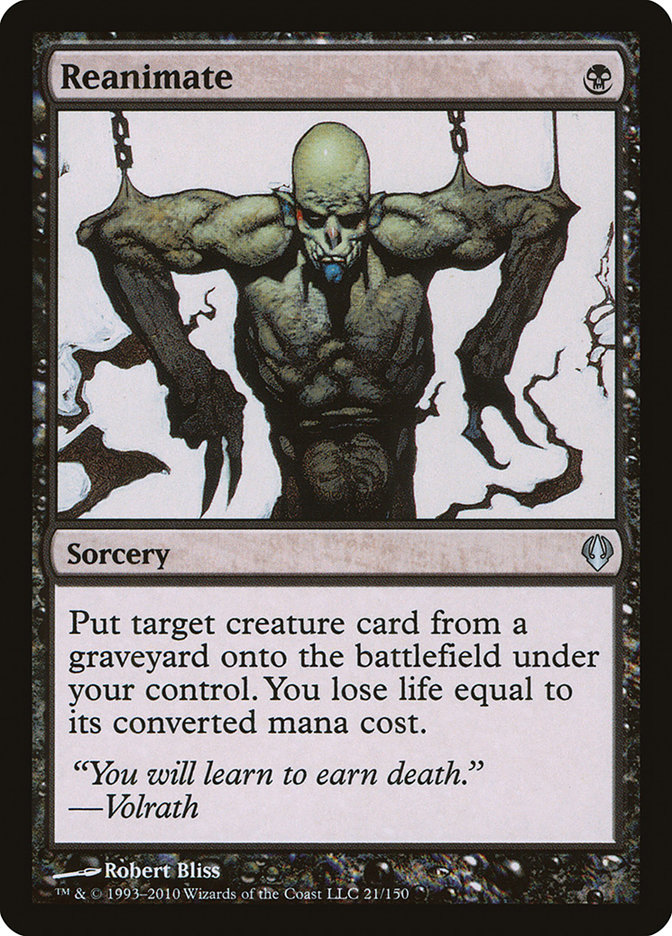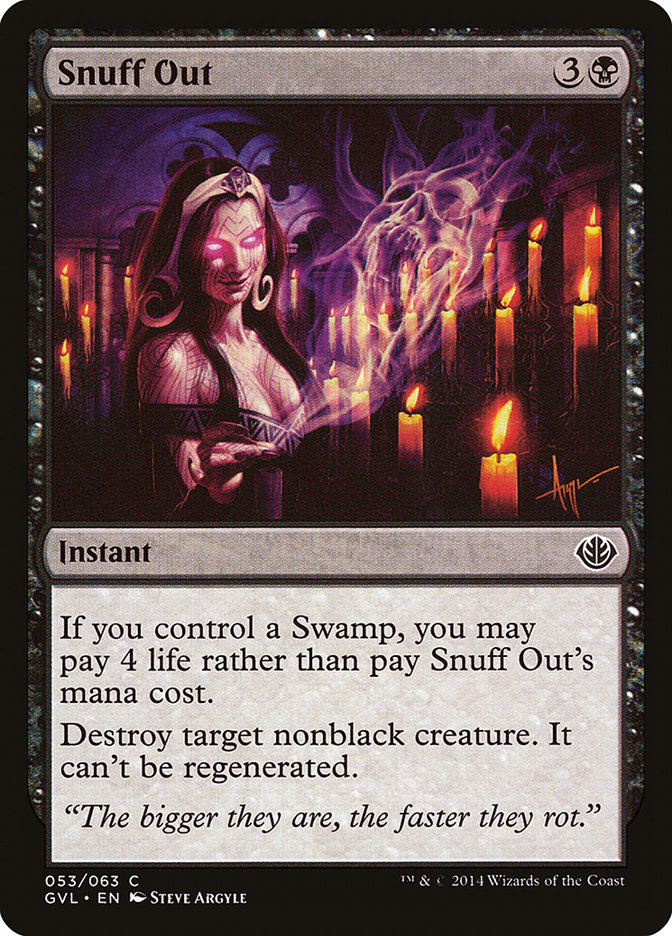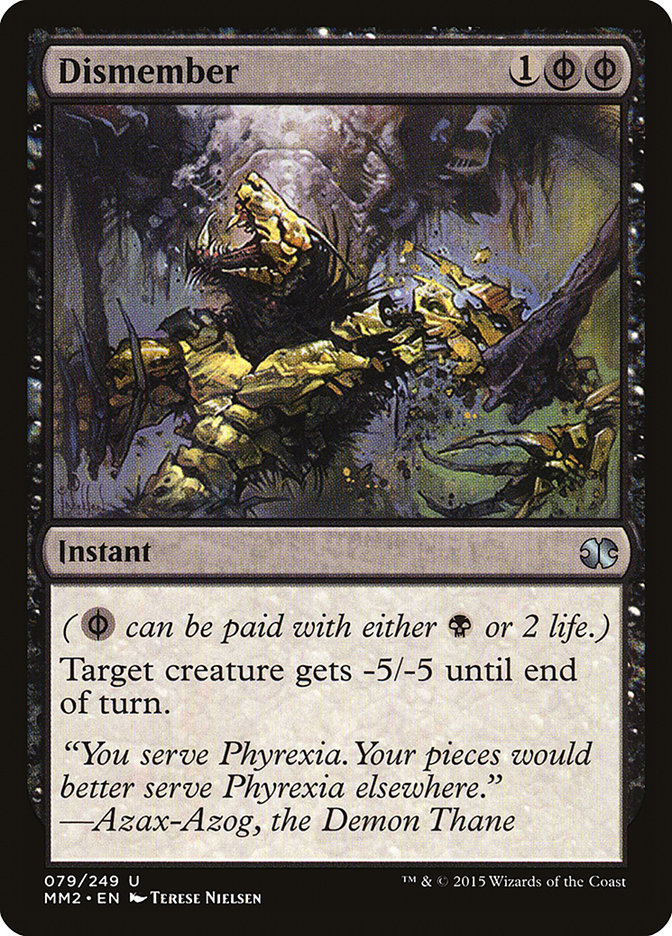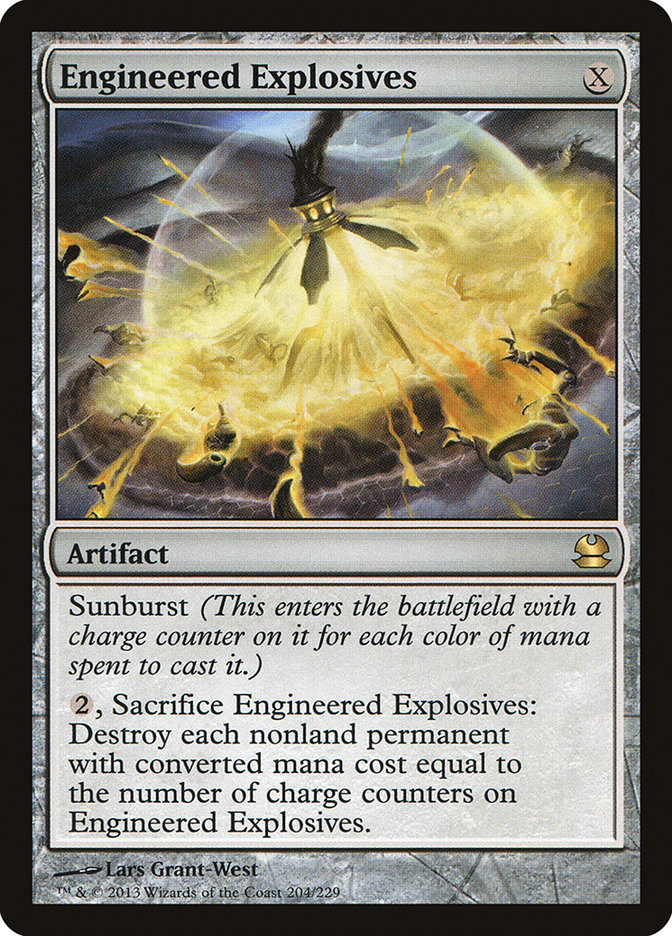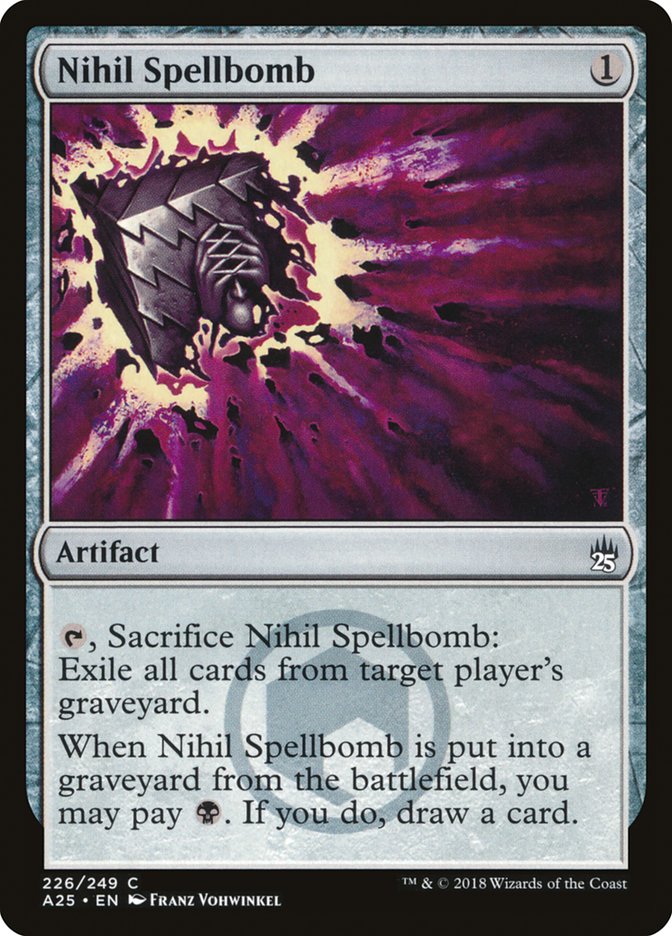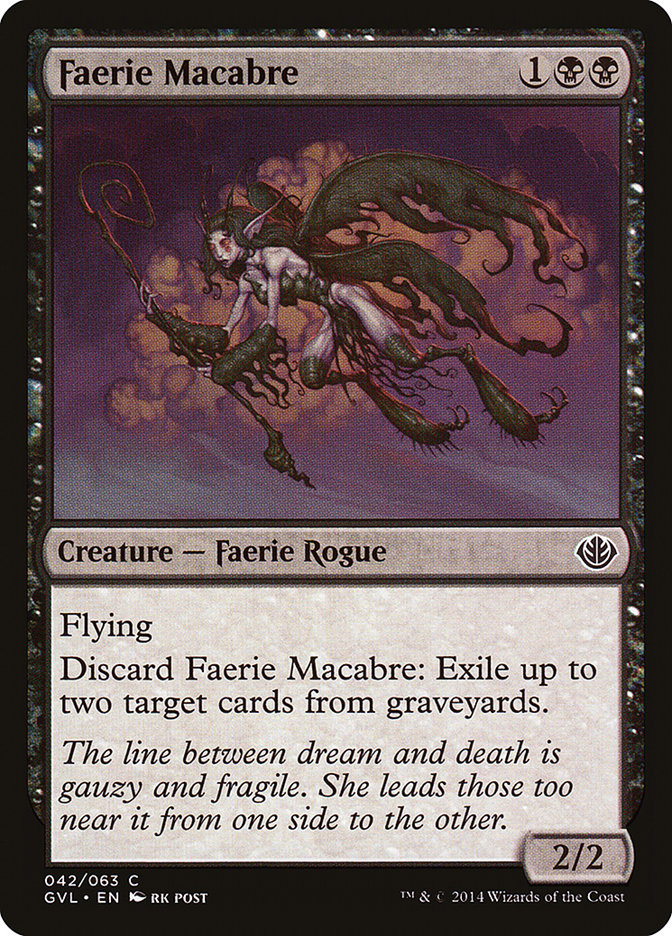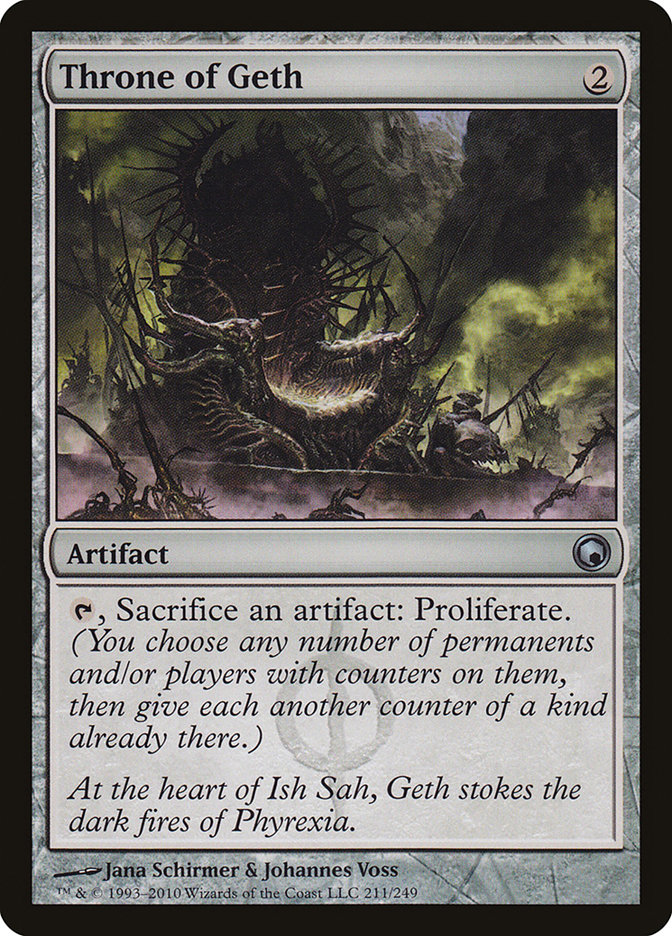With a Legacy Grand Prix as the first event this weekend in Richmond, I
wanted to spend today going over the hottest new deck in Legacy: U/B
Death’s Shadow. Unless you’ve been living under a rock, you should be aware
of this new monstrosity developed by Josh Utter-Leyton (Wrapter) at #PT25A.
While it was a Team Constructed event, featuring all three major
Constructed formats, Legacy was in the spotlight for a significant portion
of the broadcast. For starters, Legacy hasn’t been shown on the Pro Tour
stage in years, and is rarely a part of the curriculum for pro players. As
such, having a fresh format to spotlight was awesome, but it also allowed
players in the event the chance to “break” a format that was relatively
unexplored.
Isn’t it funny how Gitaxian Probe being banned in Modern and Legacy
ultimately resulted in two behemoths featuring the card Death’s Shadow?
And that’s just it. Not a lot of people saw Wrapter’s U/B Death’s Shadow
deck and thought anything other than “this deck looks sweet.” What I saw
was unprecedented. What I saw was a new deck that utilized a lot of
existing tools that Legacy had to offer, but attacked in a much different
manner. What I saw was the emergence of Legacy’s best deck.
And it isn’t even close.
When I started the broadcast for #SCGDFW a
few weekends ago alongside Cedric Phillips, all I wanted was to see U/B
Death’s Shadow on camera in Legacy. It took multiple rounds for that to
happen, as there weren’t a lot of pilots in the room, but when we were
lucky enough to have David Thomas square off against Tannon Grace, it was
just…well why don’t you take a look for yourself.
If you’re on the fence about playing U/B Death’s Shadow, just go ahead and
jump on over. The water’s fine. Not only is U/B Death’s Shadow the best
Delver deck in Legacy, I’m of the opinion that it is just the best overall
deck by a wide margin.
-It has a great combo matchup, attacking with discard, counterspells, and
Wasteland.
-It has a great Delver matchup, with cheap removal and a lower overall
curve to help fight Daze.
-It has access to some of the best sideboard tools in the format.
Like any Death’s Shadow deck we’ve seen in Modern, this U/B Death’s Shadow
deck in Legacy uses its life total like another resource. Making your deck
thinner via Street Wraith is awesome while also giving you some added
pressure on early turns, thanks to Reanimate. Having ways to manipulate
your life total so that Death’s Shadow is a bigger threat in early turns is
huge, and especially so when very few decks in Legacy can actually punish
you for it.
The reason why Death’s Shadow has fallen out of favor in Modern isn’t
because the deck is bad. It’s because more decks started to crop up that
punished you for dealing yourself too much damage. In Legacy, you don’t
have the luxury to play decks like Humans or Burn because they’re too
linear. The deck that most closely resembles Humans in Legacy is Death and
Taxes, and that deck, unlike Humans, just can’t punish you for dealing
yourself damage. Plus, they have a huge vulnerability to Dread of Night,
which Wrapter correctly identified as being powerful enough to justify
three whole copies.
What a lot of people don’t realize is that U/B Death’s Shadow isn’t just a
“Death’s Shadow” deck. It’s a tempo deck that can lean on any number of
different threats to get the job done. And while drawing multiple threats
is often good to help fight through removal, you don’t always need them to
close games. Much like Temur Delver in the years before it, U/B Death’s
Shadow can just play an early Delver of Secrets and use all forms of
disruption to ride it to victory. And while most Delver decks just rely on
Wasteland, Daze, and Force of Will, the Death’s Shadow deck gets to add
another major player to the party.
Thoughtseize has long been one of the better forms of disruption in Legacy,
but just never found a great home. Combo decks like Storm wanted Cabal
Therapy because it paired better with Gitaxian Probe, and your life total
mattered for things like Ad Nauseam. Some forms of Delver (namely Sultai
Delver) would occasionally play Hymn to Tourach, but two mana often made it
too slow and/or vulnerable to Spell Pierce or Daze. But as a longtime combo
player, namely with Sneak and Show, one of the cards that I hated playing
against the most was Thoughtseize, especially so when paired with other
forms of disruption and a fast clock.
Speaking of playing Sneak and Show against Death’s Shadow, the moment I
knew it could be a real deck was a few months ago at Grand Prix Seattle,
where I got absolutely destroyed by archetype. The games weren’t
particularly close, and I constantly felt like I had to get lucky to even
present my combo, let alone forcing it through a counterspell. I remember
winning one game by hitting a perfect Brainstorm when I was very dead, but
then quickly losing the third game without feeling like I was ever really
in it.
And that’s the sign of a good Delver deck. When you can clock your opponent
while hitting them on multiple fronts, the game should be in the bag. The
bad draws of Delver decks usually take the form of drawing too much
disruption or too many threats, as opposed to drawing a healthy mix of
both. What Death’s Shadow does by thinning the deck via Street Wraith, as
well as having a lower overall curve, means that on average you should be
casting more spells than your opponent.
I love this addition to the archetype. Reanimate gives this deck an attack
from a completely different angle. When combined with Thoughtseize, you can
occasionally KO your opponent for a single mana, taking their best threat.
And when that best threat ends up being Griselbrand out of Sneak and Show
or Reanimator, it’ll be nearly impossible for your opponent to get out of
it. Drawing seven cards is a big deal in Legacy, but having the ability to
find Force of Will or other cheap disruption helps ensure your opponent
won’t be able to put up much of a fight.
But aside from stealing one of your opponent’s threats, having a way to
bring back some of your biggest baddies is huge too. Before we ever saw the
decklists for U/B Death’s Shadow from the Pro Tour, I actually assumed
Snapcaster Mage would be hanging out in these lists. After all, Snapcaster
Mage works well with Reanimate, giving you two threats for the price of
one. However, after watching Wrapter bring back Street Wraith on the first
turn in one of the games, I knew that Reanimate was in the deck to give you
more “Delver-esque” threats on the first turn.
While it does deal you a hefty amount of damage to Reanimate a Street
Wraith, that’s usually enough to let you start casting Death’s Shadow on
the following turn. And, if we’re being frank, swampwalk is not an
irrelevant ability, especially so in the mirror. Having a three-power
creature on the first turn that dodges most of the removal is a big deal
and one that can’t be blocked to boot is going to be problematic for most
U/B/X decks. As we saw in the video above, a single Street Wraith was
all-she-wrote for Tannon Grace in the first game, so much so that he opted
to go for the ultra risky play of using Wasteland when his opponent already
had pressure on the battlefield. He knew that his only real way to win from
that point was for David Thomas to not have another land. Risky? Yes. The
right play considering the situation? I think so.
In times past, I’ve been under the impression that being on the draw
against an opposing Delver deck can lead to some lopsided games. It only
got worse as Deathrite Shaman started to show up more and more, leading to
one player gaining an absurd mana advantage when they got to untap with
Deathrite Shaman first. And when you had starts that killed your opponent’s
Deathrite Shaman and/or used Wasteland in addition to that start, the game
was over before it began. Now, without Deathrite Shaman, creatures like
Street Wraith or Delver of Secrets on the first turn can spell disaster in
Delver mirrors because they represent a lot of damage when backed by
disruption. And if you don’t have an answer for that creature, sometimes
your only route to victory is a Hail Mary, even if that means risking it on
the first turn.
Ben Friedman wrote a great
introductory piece to U/B Death’s Shadow
a short while ago where this was his main focus. And he correctly asserted
that if more people start playing Death’s Shadow, or relying on Gurmag
Angler to do a lot of heavy lifting, having one of your big removal spells
actually kill Gurmag Angler is important. But there is a real cost to
playing Dismember over Snuff Out. Every mana you spend makes you more
vulnerable to Daze, and having free spells was one of the biggest draws,
for me, of playing U/B Death’s Shadow in the first place.
I think David Thomas correctly identified that playing one of each was
correct, as it gave you the ability to have blowout turns like we saw
against Tannon Grace, but having that one Dismember also gives you an out
to an opposing Gurmag Angler if they’re able to kill one of your big
blockers.
Both of these cards are great in their own way because they answer
different threats. But you can’t forget the fact that there is a huge delta
between their casting costs. After all, most of us can agree that removal
spells like Lightning Bolt and Fatal Push are more desirable than Cast
Down. And though Cast Down can deal with a wider array of creatures, the
difference in mana cost is significant.
Building the Best Sideboard
The maindeck is nearly set in stone as far as I’m concerned. Reanimate is
genius. Having one Preordain makes sense if you assume you’re going to
aggressively use fetchlands to manage your life total. After all, Ponder is
only great when you can pick the best of the three and shuffle the other
two away. When you don’t have access to a fetchland, Preordain is more
desirable. Of the creatures, the only thing I might want more of is a third
Gurmag Angler, but I understand why there are only two copies. The second
one is always pretty tough to cast.
The spell suite all makes sense, though I think you could argue that the
second Stubborn Denial might be overkill. With Thoughtseize in the mix, you
already have more disruption than most combo decks, though I can imagine
Stubborn Denial being particularly good against decks like Miracles where
Spell Pierce or Flusterstorm would be worse. It is no secret that most
counterspells outside of Daze aren’t exactly great in mirrors. The games
are way more about getting onto the battlefield and containing your
opponent, and Daze is awesome because it can stop creatures as well as
stifle the development of combo decks.
It’s possible that I don’t love Stubborn Denial because it is one of the
spells that gets sideboarded out most often, but you could make the same
case for Force of Will. If you aren’t playing against a control or combo
deck, counterspells like these aren’t exactly great. They’re either
situational, rot in your hand, or drawing multiples is particularly bad.
However, in a field as big (and likely diverse) as Grand Prix Richmond, I
can only assume that you need to come prepared for the worst, and having
access to more cards like Stubborn Denial is a good thing.
With that said, I still think the sideboard could use a little work. And if
you think U/B Death’s Shadow is going to be out in high numbers (I do), I
think you need a few ways to compensate for that.
Creatures (14)
Lands (18)
Spells (28)

This is the list that David Thomas used to help his team win #SCGDFW.
Here are the cards I would consider cutting and why:
Engineered Explosives is a cheap answer to a lot of things that Legacy can
throw at you. It has utility against decks that explode onto the
battlefield, like Elves, while also giving you another answer to annoyances
like Chalice of the Void. However, it isn’t cheap, and most of the time it
will be used to kill threats that cost one mana. And since two of your best
creatures have that same converted mana cost, I’m not inclined to keep this
around.
I don’t know if you really need four total ways to interact with your
opponent’s graveyard, and I don’t even know if Surgical Extraction and
Nihil Spellbomb even make sense. Yes, the cycling aspect of Nihil Spellbomb
is great in a deck that functions on so few resources, but the cost of one
mana can be steep when you’re on the draw. If you use Ponder, Brainstorm,
and Preordain to dig for these cards, you (usually) need to cast them in
the same turn. And while Surgical Extraction fits the bill here, I think
there might be better option.
Faerie Macabre is a card that hasn’t seen much play as of late, but is
actually a great foil to the current builds of Reanimator decks. Thanks to
Chancellor of the Annex, some of their draws just beat you through Force of
Will or even Surgical Extraction. Faerie Macabre’s ability acting much like
cycling in that you aren’t actually casting the spell means it gets around
the denial ability of Chancellor of the Annex. Plus, if you pair Faerie
Macabre with your own Reanimate, you can “build” a Delver of Secrets while
hitting your opponent with disruption.
Yes, Surgical Extraction is a great card, and dealing yourself damage might
be useful for getting out an early Death’s Shadow. Plus, Surgical
Extraction is significantly better at stifling the development of Life from
the Loam decks, stripping them of their namesake card or permanently
answering one of their bigger threats. However, I think I would lean toward
a split. After all, you’re trying to close the game quickly against Life
from the Loam decks, and taking away their engine for a turn and forcing
them to find another iteration is usually good enough.
It’s also worth noting that Surgical Extraction loses a lot of value
without access to Snapcaster Mage.
I can see a world where very few people are relying on Chalice of the Void
to get the job done. And honestly, this is a very smart answer to the
problem that Chalice of the Void poses. To boot, some of the decks trying
to beat you with Chalice of the Void are reliant on two-mana spells
(Affinity).
While I am still going to play two copies at Grand Prix Richmond, I
wouldn’t fault you for cutting them and just hoping to dodge Chalice of the
Void decks altogether. After all, they might just beat you with Blood Moon
instead, and Throne of Geth doesn’t do much against that.
I’m likely going to be playing two copies of this in my sideboard as well,
but I still don’t like it. It is a fine answer to the creatures of Death
and Taxes, as well as Young Pyromancer, and it can help rebuy threats in
matchups where games go long. But if I’m being frank, three mana is a lot
to ask out of this deck. And it’s also a lot to ask against opponent’s
playing Wasteland, Rishidan Port, Daze, and Thalia, Guardian of Thraben.
I’m definitely leaning toward cutting one.
However, this is a danger in cutting cards that are just generically good,
because those cards can be brought in against matchups where you absolutely
need to get something out of your deck. For example, if you play against a
deck where both Force of Will and Stubborn Denial are bad, having Liliana,
the Last Hope is great because it will almost always have some value.
Legacy is all about finding the right balance of “generic good stuff” and
“targeted hate cards” in the sideboard so that, if the time comes, you can
board out all of your dead cards in favor of spells that actually do
something. We see this all the time in Modern when players put big
sideboard threats or extra spot removal into their sideboard. Sure, an
extra Fatal Push or Lightning Bolt isn’t exactly going to sway any one
particular matchup too much, but it will give you a spell to bring in when
your expensive stuff is worthless.
The current sideboard for U/B Death’s Shadow offers that flexibility to an
extent, with targeted sideboard cards for spells or matchups that are quite
troublesome. When in doubt, stuff like Hymn to Tourach, Diabolic Edict, and
Liliana, the Last Hope are all fine cards in their own right. And for each
one we cut, we need to have a very good reason.
“But Todd,” you may ask, “how should I sideboard against Deck X?” Have no
fear, here is a handy sideboard guide for all the matchups that you’re
likely to play against more than once in the tournament! And considering
I’m about 90% to just copy David Thomas’s list, even though there are some
good arguments for Faerie Macabre, chances are you’re going to want a
sideboard guide using his exactly list.
Creatures (14)
Lands (18)
Spells (28)

Gurmag Angler, Death’s Shadow, and Street Wraith via Reanimate or
hard-casting are all very difficult to kill. With that said, I still think
you want all of your removal in order to help keep Delver of Secrets in
check. Otherwise, it could just run you over, and especially so when you’re
on the draw. Snuff Out would be the only removal spell I would cut, as
Dismember can handle Gurmag Angler, and Fatal Push is quite good against
everything except Gurmag Angler.
This matchup will be about who sticks more threat to the battlefield and
who uses their disruption in the right way. Cards like Stubborn Denial and
Daze should rarely be saved, as this deck does a great job at playing
around both in one way or another. If you can use them to snipe something
early without setting yourself too far back on mana, do it. Of course,
using Daze to counter something like Ponder isn’t ideal, but it could
ultimately end up having a huge effect on the game if their hand isn’t
great.
Wasteland is also pretty important, as you can function off one or two
lands well, but that just means you have one less land to cast Ponder, etc.
while also casting your threats/removal. This entire matchup revolves
around an intricate dance, where both players are afraid to attack in fear
of making their opponent’s Death’s Shadow bigger than your own. However, if
you can press your advantage early or have an answer to an opposing Death’s
Shadow, don’t be afraid to deal your opponent some damage. Just be aware
that any amount you deal to them could ultimately come back to bite you.
Out:

In:

This is one of the few Delver-style matchups where I would consider leaving
in some number of Force of Will in order to deal with some of the bigger
threats. Plus, if you’re on the draw, having a way to recoup some tempo
from your opponent could be important. While I do expect this to be a
resource battle, and drawing too many copies of Force of Will will
ultimately be a detriment, it is possible that leaving in two copies over
the Liliana, the Last Hope is correct, if only because the +1 ability
doesn’t have a huge effect on the game.
Creatures (13)
Lands (19)
Spells (28)

Against Grixis Delver, the only way you really lose is if they start
resolving stuff like True-Name Nemesis. Both matches where David Thomas
played against Tannon Grace, he absolutely destroyed him. He constantly
kept him off mana via Wasteland, kept most of his threats in check with
removal and Daze, and ultimately overpowered him with larger creatures. I
think that’s going to be a regular occurrence in this matchup, but you need
to know a few things.
-Try your best not to get to three life, as a stray Lightning Bolt could
kill you on the spot.
-Try to use most of your mana every turn, as holding up stuff like Stubborn
Denial is bad.
-Don’t be afraid to use your Thoughtseize plus Reanimate combo on one of
their better threats. They have a tough time dealing with True-Name Nemesis
too.
Out:

In:

Again, Force of Will isn’t great, but leaving in one or two copies is never
bad when you’re on the draw. This matchup should play out much the same as
the mirrors, except Liliana, the Last Hope is actually quite good. Young
Pyromancer is one of their better threats against you, so having a way to
keep it in check is awesome.
The good news for you is that they have to become the control deck in this
matchup. They can’t afford to cut Force of Will because they are going to
naturally be on the backfoot because their spells are generally more
expensive. Young Pyromancer and True-Name Nemesis are some of their best
cards against you, but the fact that they cost two and three means Daze and
Wasteland are going to play significant roles from your side.
Creatures (6)
Lands (19)
Spells (35)

This should be one of your easier matchups, because their deck just isn’t
equipped to handle being hit from all these different angles. When you
attack their hand, mana, and have counterspells to disrupt them, all while
presenting a very fast clock, they just don’t have enough time to assemble
their combo. I should know, as I’ve been on the receiving end before.
I don’t expect this version of Sneak and Show to be the “norm,” but you
definitely need to know about it because it put up the highest finish
recently. And with Death and Taxes making a big comeback in the last
handful of months, there’s a good chance they need to focus more on
Omniscience anyway.
Just remember, if you hit them with a Thoughtseize, try to take whatever
part of their combo that leaves them having to dig for another piece. Or,
if you have a lot more disruption at the ready, make sure to take the combo
piece that costs less mana. Your main goal should be forcing them to run
into Daze, as turning Daze into an actual counterspell usually means you’ve
already won. You can do this in a number of ways:
-Putting a ton of pressure on them.
-Making them discard Show and Tell instead of Sneak Attack.
-Hitting them with Wasteland.
If Daze ever becomes useless, thanks to Ancient Tomb or Lotus Petal, things
can get a little hairy.
Out:

In:

This is one of the few matchups where I advocate bringing in Surgical
Extraction against a deck that doesn’t rely on the graveyard. Thanks to
Thoughtseize, Hymn to Tourach, and counterspells, there is a very real
chance you completely cut them off of their combo(s). Either that or you
take away about half their outs.
This is one of the few downsides to having specific sideboard cards like
Dread of Night, as you don’t have the traditional generic counterspell
options, like Flusterstorm. And while you could trim some stuff here and
there to make room for that type of effect, I don’t think you really need
it. Your deck is built to prey on Sneak and Show and other combo decks like
it.
Creatures (12)
Lands (19)
Spells (29)

While Infect isn’t exactly “all the rage” at the moment in Legacy, Aaron
Barich having success with it on the SCG Tour could be a reason for all
those old-school Tom Ross fans to come out of the woodwork.
This matchup is pretty fun from both sides, but I think you’re heavily
favored. Delver variants, or other hyper-interactive strategies, are
usually the ones that keep decks like Infect in check. They want to fight
against other combo decks because they’re a slightly faster/more consistent
variation. They put themselves at a slightly weaker point by being
vulnerable to removal in order to have that increase in speed and
consistency.
If I’m playing Death’s Shadow against Infect, I want to do one of two
things: restrict their mana or kill all of their infect threats. With
removal, counterspells, and Wasteland at your disposal, picking one line
and sticking to it shouldn’t be all that difficult. Your easiest way to win
is to strand them with spells in hand. Whether that means cutting off all
their mana or killing their creatures and leaving them with useless pump
spells is entirely up to you.
Out:

In:

Daze is pretty mediocre against decks featuring a mana accelerator and a
slew of one-mana or free spells. As such, I think Daze is the worst form of
disruption you have. At the very least, Force of Will can be used to safely
take care of Blighted Agent (their best creature against you).
If you’re on the play, I think it is also fine to sideboard out Force of
Will over Daze, if only because they’ll likely have stuff like
Flusterstorm, Spell Pierce, etc. to fight back. And if you’re on the play,
your mana denial plan is significantly better. However, if you’re on the
draw, I could see Daze becoming a dead card in a hurry and especially so if
they have a slower draw that relies on killing you with Inkmoth Nexus.
In some scenarios, it is correct to use your removal spells after their
creature has dealt damage. This may seem counter-intuitive, but “showing
your hand” in the wrong spot can lead to disaster. Plus, if their
protection spell is a kicked Vines of Vastwood, you could just die on the
spot. Be careful, be smart, and don’t be afraid to take some infect damage.
After all, the only point that matters is #10.
Lands (34)
Spells (26)

While this deck hasn’t been showing up that much recently, I’ve heard some
clamoring that it has a positive matchup against Death’s Shadow. If that is
the case, then you need to make sure you know the matchup inside and out,
because a single misstep against them can lead to some bad spirals that are
virtually impossible to come back from.
For starters, they’re going to try to kill all of your lands. Every turn.
That should ultimately be their goal, because they don’t have a lot of ways
to actually kill your larger creatures. Outside of Maze of Ith, chances are
they’re soft to Gurmag Angler and Death’s Shadow. With that said, they can
occasionally invalidate Death’s Shadow by using Grove of the Burnwillows in
the early turns. And that, in turn, leads to your main source of damage
being Delver of Secrets, which is often dangerous against a deck featuring
Punishing Fire.
Game 1 is quite difficult, but you have access to some tools in the
sideboard that could help.
Out:

In:

In this matchup, a lot of your disruption is quite weak. After the first
few turns, Thoughtseize and Daze get significantly worse, but you need them
in the early going to make sure they don’t combo-kill you too quickly.
Plus, if they have a start that doesn’t feature Exploration or Mox Diamond,
Daze is often quite good.
After sideboard, try to use your Surgical Extraction to keep them off Life
from the Loam, but there is also good reason to strip them off Wasteland if
you have a mana-light draw. Try to keep pressure on them, save your
Wasteland for their combo or maybe one of their tougher-to-beat lands, like
Maze of Ith or The Tabernacle at Pendrell Vale. Trying to mana screw them
rarely works, but it could happen on occasion if you’re able to keep them
off green mana. Also be aware that they do play a lot of copies of Crop
Rotation, so using your Wasteland at the right time is key.
Creatures (25)
- 4 Mother of Runes
- 4 Flickerwisp
- 4 Stoneforge Mystic
- 1 Mirran Crusader
- 4 Phyrexian Revoker
- 4 Thalia, Guardian of Thraben
- 2 Recruiter of the Guard
- 1 Sanctum Prelate
- 1 Palace Jailer
Lands (24)
Spells (11)

This is likely the deck you’ll see the most at Grand Prix Richmond, if only
because it is one of the easier decks for people unfamiliar with Legacy to
pick up and play. Sure, it is intricate and your sequencing matters, and
mistakes are quite punishable, but the play patterns are similar to many
you see in Modern. Aether Vial decks translate very well across the two
formats, in both how to play them and what they’re trying to accomplish.
This matchup is on the tougher side, but gets significantly easier after
sideboard thanks to three copies of Dread of Night. In the first game, a
single Mother of Runes could spell your doom, but having access to that
backbreaking sideboard effect eliminates roughly half of their relevant
threats and allows your spot removal to take care of their more annoying
creatures.
Out:


In:


I think this is yet another matchup where Daze is better on the play, but
Force of Will could ultimately be better on the draw. The problem here is
that both of these cards can be blanked by Cavern of Souls or a resolved
Aether Vial. At the very least, Force of Will can counter a Swords to
Plowshares later in the game. If the finals of the Pro Tour are any
indication, Wrapter thinks that Daze should stay in most of the time, as he
used three copies to counter a hardcast Batterskull at one point.
I think there is merit to Hymn to Tourach on the play, but I don’t love it
on the draw thanks to them having Thalia, Guardian of Thraben. But since it
is a resource battle, I think I might bring them in when I’m on the play in
order to hit some of their bigger spells or utility lands. But the problem
with random discarding is that, if you already have a Dread of Night on the
battlefield, you’re likely going to hit a card from their hand that won’t
have a huge impact on the game.
…
Are there other Legacy decks? Of course! Will you face off against anything
besides these decks at the Grand Prix? Very likely. To that end, if you are
so inclined, please post any questions you might have about sideboarding in
the comments and I’ll do my best to answer them! However, there is a good
chance I won’t be able to answer everything in a timely manner this go
around, as I’ll already be in Richmond playing in a PTQ on Thursday.
Regardless, I will get to all of them as soon as I can!
If you’re attending Grand Prix Richmond or just playing a local Legacy
event, I hope you choose to pick up U/B Death’s Shadow. It’s an insanely
powerful deck that I fully expect to take over the format in a short period
of time. Does it have flaws? Obviously, and those can be exploited if
people start putting more of an emphasis on Legacy. However, U/B Death’s
Shadow cuts through almost all of these decks like butter. And until
something changes, it’s my pick for “Best Deck in Legacy.” And until
something changes, I’m going to be cycling Street Wraith in every event
until someone gives me a reason to stop!



